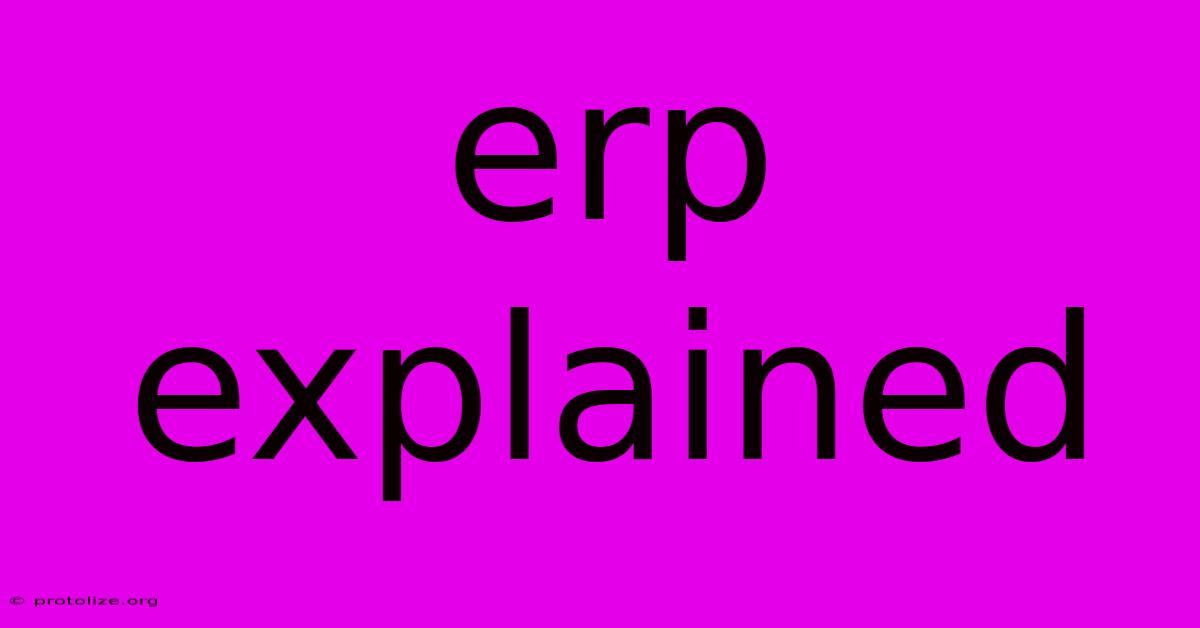Erp Explained

Discover more detailed and exciting information on our website. Click the link below to start your adventure: Visit Best Website mr.cleine.com. Don't miss out!
Table of Contents
ERP Explained: Your Guide to Enterprise Resource Planning
Enterprise Resource Planning (ERP) systems are the backbone of many successful businesses today. But what exactly is ERP, and how can it benefit your organization? This comprehensive guide will demystify ERP, exploring its core functions, benefits, and considerations for implementation.
What is ERP?
At its core, ERP is a centralized system that integrates all facets of a business's operations. This includes everything from planning and purchasing to manufacturing, sales, marketing, finance, and human resources. Instead of disparate systems working in silos, ERP brings them together under one umbrella, providing a single source of truth for all business data.
Think of it as the central nervous system of your company. It allows different departments to communicate seamlessly, share information effortlessly, and work towards common goals more efficiently.
Key Features of an ERP System:
- Inventory Management: Track stock levels, manage orders, and optimize supply chains.
- Supply Chain Management: Streamline procurement, production, and distribution processes.
- Customer Relationship Management (CRM): Manage customer interactions, track sales, and improve customer service.
- Financial Management: Handle accounting, budgeting, reporting, and financial analysis.
- Human Capital Management (HCM): Manage employee data, payroll, benefits, and performance.
- Project Management: Track projects, resources, and deadlines.
- Business Intelligence (BI): Analyze data to make informed business decisions.
Benefits of Implementing an ERP System
Adopting an ERP system offers a wide range of benefits that can significantly impact a company's bottom line and overall performance. These include:
- Improved Efficiency: Streamlined processes and automated workflows reduce manual tasks, freeing up valuable time and resources.
- Enhanced Collaboration: Breaking down data silos fosters better communication and collaboration between departments.
- Better Decision-Making: Access to real-time data and comprehensive reporting enables informed and data-driven decisions.
- Reduced Costs: Optimizing processes, reducing waste, and improving efficiency lead to significant cost savings.
- Increased Productivity: Employees can focus on strategic tasks rather than manual data entry and reconciliation.
- Improved Customer Service: Better inventory management and streamlined order processing lead to faster delivery times and improved customer satisfaction.
- Better Inventory Control: Accurate inventory tracking minimizes stockouts and overstocking, reducing waste and improving profitability.
- Scalability and Flexibility: Many ERP systems are designed to grow with your business, adapting to changing needs and expanding operations.
Choosing the Right ERP System
Selecting the right ERP system is crucial for success. Several factors need careful consideration:
- Business Size and Needs: A small business will have different requirements than a large enterprise.
- Industry-Specific Requirements: Certain industries have unique needs that require specialized ERP solutions.
- Integration Capabilities: Ensure the system integrates seamlessly with existing software and hardware.
- Scalability and Flexibility: Choose a system that can adapt to your growing business needs.
- Cost of Implementation and Maintenance: Factor in the initial investment, ongoing maintenance costs, and potential training expenses.
- Vendor Support and Reputation: Select a reputable vendor with a proven track record and excellent customer support.
ERP Implementation: A Step-by-Step Process
Implementing an ERP system is a significant undertaking that requires careful planning and execution. The process generally involves:
- Needs Assessment: Identify your business needs and requirements.
- Vendor Selection: Research and select a suitable ERP vendor.
- System Customization: Customize the system to meet your specific needs.
- Data Migration: Migrate existing data from legacy systems to the new ERP system.
- User Training: Provide comprehensive training to all users.
- Go-Live and Post-Implementation Support: Launch the system and provide ongoing support and maintenance.
Implementing an ERP system is a substantial investment, but the long-term benefits often outweigh the initial costs. Careful planning, thorough research, and a commitment to user training are key to a successful implementation. By carefully considering these factors, businesses can leverage the power of ERP to streamline operations, improve efficiency, and achieve sustainable growth. Choosing the right ERP system and implementing it effectively can significantly transform your business, positioning it for success in today's competitive market.

Thank you for visiting our website wich cover about Erp Explained. We hope the information provided has been useful to you. Feel free to contact us if you have any questions or need further assistance. See you next time and dont miss to bookmark.
Featured Posts
-
New Thriller Clementine From Gout
Dec 13, 2024
-
Romania Bulgaria Join Schengen In 2025
Dec 13, 2024
-
John Pesutto Remains Leader
Dec 13, 2024
-
Chat Gpt Downtime Resolved By Open Ai
Dec 13, 2024
-
Erp Group
Dec 13, 2024
